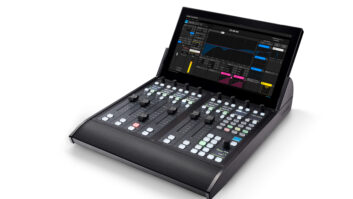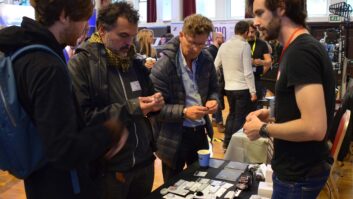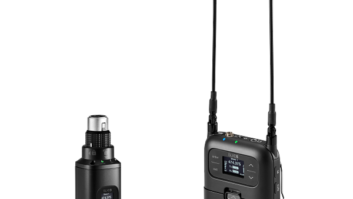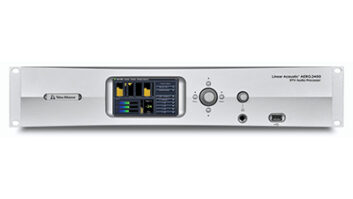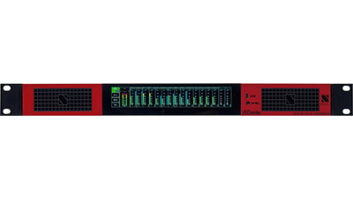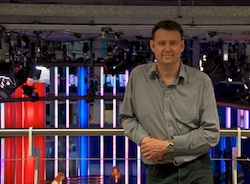
In the UK, the changeover of radio frequency spectrum for wireless audio, prompted by the digital switchover, is due to be completed at the end of 2012 (earlier depending on location), which means that all broadcast users have had to re-equip this year.
When Sky News went shopping, it had been very happy with its existing systems, but was hoping for something that offered an improvement in all areas. Its Sennheiser kits “had been very reliable and very robust,” says its Head of Cameras, George Davies (pictured).
The new system needed to have dual channel receivers, better range, and improved audio quality. As Sennheiser didn’t do dual channel models, Sky had to look elsewhere.
Other considerations were how rugged the systems were. “Plastic casings don’t survive very well in a news environment.” It also had to fit into the existing camera equipment, so form factor was important. All of its ENG camera fleet are Panasonic P2 camcorders, which it bought about five years ago – one of the first news organisations anywhere to move completely to solid state and HD.
“We wanted as wide a range of frequencies, both in reception and transmission, as possible, to allow more international support with less equipment,” he explains.
Its final choice was to equip all of its ENG cameras with Wisycom radio microphone systems supplied by Raycom, with almost 100 of the dual channel MCR42 slot-in receivers with a 240MHz tuning range and a selection of matching hand held, belt pack and plug-on transmitters. Raycom also supplied DPA microphones for some of the systems.
“The receivers are truly global, and will cover all frequencies, worldwide. The transmitter requires only two bands to cover all countries – it’s hard to get a transmitter to work efficiently for the full range,” although he has heard that Raycom hopes to have a full-range transmitter working in its next-generation systems.
Although it meets all of Sky’s requirements for frequency spectrum, robustness and sound quality, there were a few operational features that weren’t perfect, and Sky wanted a few modifications to simplify menu choices, for example, which will be in the next software version.
“Most of the people that have been using them have been very pleased with them. They think they have improved range, and find the receivers reasonably simple to navigate,” says Davies. The modifications Sky wants will “improve the usability of the device for news crews, who are very busy and don’t have time to read the instruction manual when they need to change something.”
It has some 96 systems in use, most with two transmitters and one receiver. Most are on UK frequencies, but because the bandwidth is so wide, the transmitters can also meet the RF specifications for other countries, which can be selected reasonably simply, as Davies programmed in the bandwidth selections for each country on a computer, then downloaded it to the systems.
“The cameramen don’t care what the frequency is. They just need to have a number of legal channels for each country,” he says.
The UK, like most of Europe, can be covered by the low band transmitter, while the high band transmitter is needed in fewer countries, mainly in the Middle East. “There are far more low band countries in the world than high band, but our receivers do all of it.” Sky Sports, Sky Sports News, Sky Sports F1 HD, BBC News Channel and ITV are also using the Wisycom systems.
Getting the signal back
To get news reports back to base, Sky uses a wide range of technologies, from copper cable to various wireless links, such as LiveU or Dejero, and various satellite systems. It uses standard 3G dongles for feeds and occasionally for live use if there is a good enough signal, via a laptop.
“One of the problems with 3G, whether combining multimode or single dongles, is that cellular networks at a big event become overwhelmed, and the bandwidth just falls off,” making it unusable.
It such cases it might use hotel broadband, if available, or smaller satphones, such as BGAN. It also has its own MPLS (Multi Protocol Label Switching) network around London, and if a report is near one of the ingest points, it can set up a Wi-Fi network and link back via this.
Beyond this, “the only reliable way to guarantee transmission from anywhere, at anytime, is satellite,” he says, so it has a variety of satellite systems including IP-based Tri-Sat, some older Norsat, and various forms of generic uplink dishes. Sky also has about a dozen uplink trucks, spread around the UK and in Brussels, which are available to news when necessary.
But for a mobile cameraman, especially having to fly anywhere, being able to have a full kit, including camera, laptop and BGAN phone, in carry-on luggage means “they aren’t reliant on anything around them to get the story back.” Although if there is a better signal available, such as 3G or broadband, even better. If the story grows, Sky can send a full uplink. “It’s very dynamic and all entirely story dependent,” says Davies.
It also uses some domestic broadband over satellite systems. Although these offer limited bandwidth, “it’s better than BGAN and smaller than a full uplink.”
Sky uses a system from Tooway, which can provide 4Mb uplink in the UK and across Europe, and even in some places in the Middle East. Unfortunately, the bandwidth isn’t high enough to meet broadcast spec, and it still needs a dish that has to be set up and powered, but it is an indication of how domestic alternatives are advancing.
“When you can have fibre to the home at 80Mb, the line between what is domestic and what is commercial is very blurred.” In the UK, Sky (which offers broadband and telephone to its customers as well as satellite TV), is rolling out its own FTTH network, and Davies sees “potentially huge savings, if the availability is there” in using this fibre.
“In some cities a 3G dongle can give a 2.6Mb uplink, our current record. That exceeds BGAN and often hotel broadband, but there are some days you can’t even get a signal.”
In the near future there will also be 4G. Like 3G, such services can be great in theory, but we have to see how well they work in operation. “All telcos want to run their system up to capacity. That doesn’t leave much space for a big event to happen and to cope with it.” 4G will just be another tool that will be good in some locations but not everywhere. “You can still drive to places in the country and not even get a 2G phone signal,” he says.
P2 Workflow at Sky
When Sky News originally moved to P2, it was “very conscious that the workflow had to help, not hinder. We looked at other non-linear workflows that involved checking of card locations, barcodes and people signing for expensive cards, and all that struck us as a hindrance.”
Its system involves nobody having to sign for anything, the card ending up somewhere to get the video off it, and being recycled. “To the cameraman it is the same as tape workflow as far as handling the card on the road. He hands it off to the journalist and waves it goodbye.” In London it will be ingested at Sky’s Millbank studio in Westminster or at its HQ in Osterley, west London. Elsewhere in the UK and at its foreign bureaux, it uses cameraman/editors, so the cards don’t leave the cameramen. Once the rushes are ingested, they are handled and archived by Sky’s EVS and Ardome systems.
There have been very few card failures, and it has lost less than 1% of its card stock of some 650 cards in five years via this workflow (not counting carjackings or war zones), “which is phenomenally good.”
It means the cost benefit of cards versus tape is considerable. The cards have typically done 500 to 1000 cycles each, which means they have cost no more than £1 per use, compared to a ten-use tape, which would cost about £2.50 per use. That is before you factor in reliability, ingest speed, and the fact that users can ingest into a laptop on location using just a relatively inexpensive card reader, “so the equipment you need to carry to Iraq or Afghanistan can fit in a backpack.”
There has also been an improvement in camera reliability, with no tape mechanism to go wrong. “There have been breakdowns, but fewer than there would have been with tape.”
When Sky News bought the cameras, it was a pioneer in moving all acquisition to HD, but Davies says that even then the cost differential between SD and HD wasn’t much, and “it enabled us to start building an HD archive,” more than two years before it started transmitting in HD.
Sky is renowned for thinking ahead, so Davies is already looking at how it should replace the P2 cameras in a couple of years or so. “Our priorities will be: faster, lighter, reduced power consumption, and more connectivity. Everything’s going H.264 and IP, so the next generation cameras need IP encoders built in […] We spend our lives bolting IP encoders onto the backs of cameras.”
They will also want to move beyond HD-SDI at 1.5Gbps, as moving to 1080p will require 3Gbps. Of course, by then Sky’s long term requirements will probably have moved on, so 3D and/or 4k (or even 8k) could be on the horizon – even for news.
By David Fox
